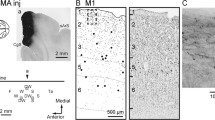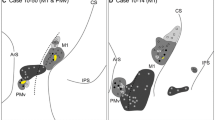Abstract
The goal of the present neuroanatomical study in macaque monkeys was twofold: (1) to clarify whether the hand representation of the primary motor cortex (M1) has a transcallosal projection to M1 of the opposite hemisphere; (2) to compare the topography and density of transcallosal connections for the hand representations of M1 and the supplementary motor area (SMA). The hand areas of M1 and the SMA were identified by intracortical microstimulation and then injected either with retrograde tracer substances in order to label the neurons of origin in the contralateral motor cortical areas (four monkeys) or, with an anterograde tracer, to establish the regional distribution and density of terminal fields in the opposite motor cortical areas (two monkeys). The main results were: (1) The hand representation of M1 exhibited a modest homotopic callosal projection, as judged by the small number of labeled neurons within the region corresponding to the contralateral injection. A modest heterotopic callosal projection originated from the opposite supplementary, premotor, and cingulate motor areas. (2) In contrast, the SMA hand representation showed a dense callosal projection to the opposite SMA. The SMA was found to receive also dense heterotopic callosal projections from the contralateral rostral and caudal cingulate motor areas, moderate projections from the lateral premotor cortex, and sparse projections from M1. (3) After injection of an anterograde tracer (biotinylated dextran amine) in the hand representation of M1, only a few small patches of axonal label were found in the corresponding region of M1, as well as in the lateral premotor cortex; virtually no label was found in the SMA or in cingulate motor areas. Injections of the same anterograde tracer in the hand representation of the SMA, however, resulted in dense and widely distributed axonal terminal fields in the opposite SMA, premotor cortex, and cingulate motor areas, while labeled terminals were clearly less dense in M1. It is concluded that the hand representations of the SMA and M1 strongly differ with respect to the strength and distribution of callosal connectivity with the former having more powerful and widespread callosal connections with a number of motor fields of the opposite cortex than the latter. These anatomical results support the proposition of the SMA being a bilaterally organized system, possibly contributing to bimanual coordination.
Similar content being viewed by others
References
Aizawa H, Mushiake H, Inase M, Tanji J (1990) An output zone of the monkey primary motor cortex specialized for bilateral hand movement. Exp Brain Res 82:219–221
Barbas H, Pandya DN (1987) Architecture and frontal cortical connections of the premotor cortex (area 6) in the rhesus monkey. J Comp Neurol 256:211–228
Brinkman C (1984) Supplementary motor area of the monkey's cerebral cortex: short- and long-term deficits after unilateral ablation and the effects of subsequent callosal section. J Neurosci 4:918–929
Brinkman C, Porter R (1979) Supplementary motor area in the monkey: activity of neurons during performance of a learned motor task. J Neurophysiol 42:681–709
Bogen JE (1985) The callosal syndromes. In: Heilman KM, Valenstein E (eds) Clinical neuropsychology. Oxford University Press, New York, pp 295–338
Brodal P (1992) The cerebral cortex and limbic structures: connections of the cerebral cortex. In: The central nervous system, structure and function. Oxford University Press, Oxford, pp 406–413
De Vito JL, Smith OA (1959) Projections from the mesial frontal cortex (supplementary motor area) to the cerebral hemispheres and brain stem of the macaca mulatta. J Comp Neurol 111:261–278
Dum RP, Strick PL (1991) The origin of corticospinal projections from the premotor areas in the frontal lobe. J Neurosci 11:667–689
Ericson H, Blomqvist A (1988) Tracing of neuronal connections with cholera toxin subunit B: light and electron microscopic immunohistochemistry using monoclonal antibodies. J Neurosci Methods 24:225–235
Gould HJ III, Cusick CG, Pons TP, Kaas JH (1986) The relationship of the corpus callosum connections to electrical simulation maps of motor, supplementary motor and the frontal eye fields in owl monkeys. J Comp Neurol 247:297–325
Guiard Y, Requin J (1978) Between-hand vs within-hand choice RT: a single channel of reduced capacity in the split-brain monkey. In: Requin J (ed) Attention and performance, VII. Erlbaum, Hillsdale
He S-Q, Dum RP, Strick PL (1993) Topographic organization of corticospinal projections from the frontal lobe: motor areas on the lateral surface of the hemisphere. J Neurosci 13:952–980
Jenny AB (1979) Commissural projections of the cortical hand motor area in monkeys. J Comp Neurol 188:137–146
Johnson PB, Angelucci A, Ziparo RM, Minciacchi D, Bentivoglio M, Caminiti R (1989) Segregation and overlap of callosal and association neurons in frontal and parietal cortices of primates: a spectral and coherency analysis. J Neurosci 9:2313–2326
Jones EG (1986) Connectivity of the primate sensory-motor cortex. In: Jones EG, Peters A (eds) Cerebral cortex, vol 5. Plenum Press, New York, pp 113–183
Jones EG, Coulter JD, Wise SP (1979) Commissural columns in the sensory-motor cortex of monkeys. J Comp Neurol 188:113–136
Jürgens U (1984) The efferent and afferent connections of the supplementary motor area. Brain Res 300:63–81
Kazennikov O, Wicki U, Corboz M, Hyland B, Palmeri A, Rouiller EM, Wiesendanger M (1994) Temporal and spatial structure of a bimanual goal-directed movement sequence in monkeys. Eur J Neurosci 6:203–210
Killackey HP, Gould HJ III, Cusick CG, Pons TP, Kaas JH (1983) The relation of corpus callosum connections to architectonic fields and body surface maps in sensorimotor cortex of New and Old World monkeys. J Comp Neurol 219:384–419
Kim S-G, Ashe J, Georgopoulos AP, Merkle H, Eilermann JM, Menon RS, Ogawa S, Ugurbil K (1993a) Functional imaging of human motor cortex at high magnetic field. J Neurophysiol 69:297–302
Kim S-G, Ashe J, Hendrich K, Ellermann JM, Merkle H, Ugurbil K, Georgopoulos AP (1993b) Functional magnetic resonance imaging of motor cortex: hemispheric asymmetry and handedness. Science 261:615–617
Künzle H (1978a) An autoradiographic analysis of the efferent connections from premotor and ajacent prefrontal regions (areas 6 and 9) in Macaca fascicularis. Brain Behav Evol 15:185–234
Künzle H (1978b) Cortico-cortical efferents of primary motor and somatosensory regions of the cerebral cortex in Macaca fascicularis. Neuroscience 3:25–39
Leichnetz GR (1986) Afferent and efferent connections of the dorsolateral precentral gyrus (area 4, hand/arm region) in the macaque monkey, with comparison to area 8. J Comp Neurol 254:460–492
Liang F, Wan XST (1989) Improvement of the tetramethyl benzidine reaction with ammonium molybdate as a stabilizer for light and electron microscopic ligand-HRP neurohistochemistry, immunocytochemistry and double-labeling. J Neurosci Methods 28:155–162
Luppi P-H, Sakai K, Salvert D, Fort P, Jouvet M (1987) Peptidergic hypothalamic afferents to the cat raphe pallidus as revealed by a double immunostaining technique using unconjugated cholera-toxin as retrograde tracer. Brain Res 402:339–345
Luppino G, Matelli M, Camarda RM, Gallese V, Rizzolatti G (1991) Multiple representations of body movements in mesial area 6 and the adjacent cingulate cortex: an intracortical microstimulation study in the macaque monkey. J Comp Neurol 311:463–482
Luppino G, Matelli M, Camarda R, Rizzolatti G (1993) Corticocortical connections of area F3 (SMA-proper) and area F6 (pre-SMA) in the macaque monkey. J Comp Neurol 338:114–140
Macpherson JM, Marangoz C, Miles TS, Wiesendanger M (1982) Microstimulation of the supplementary motor area (SMA) in the awake monkey. Exp Brain Res 45:410–416
Matelli M, Luppino G, Rizzolatti G (1985) Patterns of cytochrome oxidase activity in the frontal agranular cortex of the macaque monkey. Behav Brain Res 18:125–136
Matelli M, Luppino G, Rizzolatti G (1991) Architecture of superior and mesial area 6 and the adjacent cingulate cortex in the macaque monkey. J Comp Neurol 311:445–462
Matsuzaka Y, Aizawa H, Tanji J (1992) A motor area rostral to the supplementary motor area (presupplementary motor area) in the monkey: neuronal activity during a learned motor task. J Neurophysiol 68:653–662
McGuire PK, Bates JF, Goldman-Rakic PS (1991) Interhemispheric integration. I. Symmetry and convergence of the corticocortical connections of the left and the right principal sulcus (PS) and the left and the right supplementary motor area (SMA) in the rhesus monkey. Cereb Cortex 1:390–407
Mesulam MM (1982) Principles of horseradish peroxidase neurohistochemistry and their applications for tracing neural pathways. In: Mesulam MM (ed) Tracing neural connections with HRP. Wiley & sons, Chichester, pp 1–151
Muakkassa KF, Strick PL (1979) Frontal lobe inputs to primate motor cortex: evidence for four somatotopically organized “premotor” areas. Brain Res 177:176–182
Pandya DN, Vignolo LA (1971) Intra- and interhemispheric projections of the precentral, premotor and arcuate areas in the Rhesus monkey. Brain Res 26:217–233
Penfield W, Jasper H (1954) Epilepsy and the functional anatomy of the human brain. Boston: Little, Brown & Co, Boston
Preilowski B (1990) Intermanual transfer, interhemispheric interaction and handedness in man and monkeys. In: Trevarthen C (ed) Brain circuits and functions of the mind. Cambridge University Press, Cambridge, pp 168–180
Ringo JL, Doty RW, Demeter S, Simard PY (1994) Time is of the essence: a conjecture that hemispheric specialization arises from interhemispheric conduction delay. Cereb Cortex 4:331–343
Rouiller EM, Moret V, Liang F (1993) Comparison of the connectional properties of the two forelimb areas of the rat sensorimotor cortex: support for the presence of a premotor or supplementary motor cortical area. Somatosens Mot Res 10:269–289
Rouiller EM, Liang F, Babalian A, Moret V, Wiesendanger M (1994) Cerebello-thalamo-cortical and pallido-thalamo-cortical projections to the primary (M1) and supplementary (SMA) motor cortical areas: a multiple tracing study in macaque monkeys. J Comp Neurol 345:185–213
Sessle BJ, Wiesendanger M (1982) Structural and functional definition of the motor cortex in the monkey (Macaca fascicularis). J Physiol (Lond) 323:245–265
Stepniewska I, Preuss TM, Kaas JH (1993) Architectonics, somatotopic organization, and ipsilateral cortical connections of the primary motor area (M1) of owl monkeys. J Comp Neurol 330:238–271
Tanji J (1994) The supplementary motor area in the cerebral cortex. Neurosci Res 19:251–268
Tanji J, Okano K, Sato KC (1988) Neuronal activity in cortical motor areas related to ipsilateral, contralateral, and bilateral digit movements of the monkey. J Neurophysiol 60:325–343
Travis AM (1955) Neurological deficiencies following supplementary motor area lesions in Macaca mulatto. Brain 78:174–198
Veenman CL, Reiner A, Honig MG (1992) Biotinylated dextran amine as an anterograde tracer for single- and double-labeling studies. J Neurosci Methods 41:239–254
Wan XST, Liang F, Moret V, Wiesendanger M, Rouiller EM (1992) Mapping of the motor pathways in rats: c-fos induction by intracortical microstimulation of the motor cortex correlated with efferent connectivity of the site of cortical stimulation. Neuroscience 49:749–761
Wiesendanger M (1981) Organization of secondary motor areas of cerebral cortex. In: Brooks VB (ed) Motor control. Handbook of physiology, sect 1, the nervous system, vol II, part II. American Physiological Society, Washington D.C. pp 1121–1147
Wiesendanger M (1986) Recent developments in studies of the supplementary motor area of primates. Rev Physiol Biochem Pharmacol 103:1–59
Wiesendanger M (1993) The riddle of supplementary motor area function. In: Mano N, Hamada I, DeLong MR (eds) Role of the cerebellum and basal ganglia in voluntary movement. Elsevier, Amsterdam, pp 253–266
Wiesendanger M, Wise SP (1992) Current issues concerning the functional organization of motor cortical areas in nonhuman primates. Adv Neurol 57:117–134
Wiesendanger M, Wicki U, Rouiller E (1993) Are there unifying structures in the brain responsible for interlimb coordination? In: Swinnen SP, Heuer H, Massion J, Casaer P (eds) Interlimb coordinaton: neural, dynamical and cognitive constraints. Academic, San Diego, pp 179–207
Author information
Authors and Affiliations
Additional information
On leave from the Institute of Physiology, Armenian Academy of Sciences, Erevan, Armenia
Rights and permissions
About this article
Cite this article
Rouiller, E.M., Babalian, A., Kazennikov, O. et al. Transcallosal connections of the distal forelimb representations of the primary and supplementary motor cortical areas in macaque monkeys. Exp Brain Res 102, 227–243 (1994). https://doi.org/10.1007/BF00227511
Received:
Accepted:
Issue Date:
DOI: https://doi.org/10.1007/BF00227511




